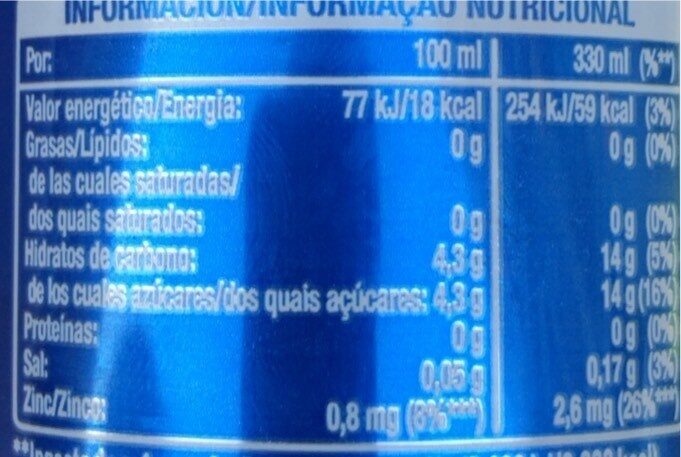Aquarius Naranja - Coca-Cola - 330 ml
This product page is not complete. You can help to complete it by editing it and adding more data from the photos we have, or by taking more photos using the app for Android or iPhone/iPad. Thank you!
×
Código de barras: 5449000033819 (EAN / EAN-13)
Cantidade: 330 ml
Empaquetado: es:Green dot
Marcas: Coca-Cola
Categorías: en:Beverages, en:Artificially sweetened beverages, en:Diet beverages, en:Dietary drink for sport, en:Sweetened beverages
Etiquetas, certificacións, premios:
en:Green Dot, en:With sweeteners, es:Recicla-amarillo

Link to the product page on the official site of the producer: https://www.cocacolaespana.es/bebidas/aq...
Tendas: Mercadona, Caprabo, Consum, Condis, Carrefour, Amazon, Convenience store, Spar
Matching with your preferences
Medio ambiente
Empaquetado
Transportation
Report a problem
Data sources
Product added on by openfoodfacts-contributors
Last edit of product page on by redspider.
Páxina do produto tamén editada por acuario, alia, chevalstar, cocopops2023, duhowpi, ecoscore-impact-estimator, entarabicuadriculado, foodless, fradelg, inf, kiliweb, kimrotu, musarana, roboto-app, segundo, thaialagata, yuka.V2ZBOEg0Z1J1c1FobDloaDdpS0sydDk0OWFEd2YwK3BGYzBYSVE9PQ, yuka.Wkx4WkMva3ZndDhJZ3ZBY3BrenR4ZFFzd1oyc2VWK3BFOGhPSUE9PQ, yuka.YklWY0dZZ04vZFVibU1RZDJCYmEvOWhFMXMrTVkzUHRCUEFOSVE9PQ, yuka.sY2b0xO6T85zoF3NwEKvlhR2btDamwDdGBDhm026yeqpFqPqeYojwJTAFqs, yuka.sY2b0xO6T85zoF3NwEKvlhZBafX9ug30LUPWiWSZ_43WAb6yb9N0uqqqPKg, yuka.sY2b0xO6T85zoF3NwEKvlhd-ffDyoxDJbwXnoXLR_-yeCpjZTft02oiiEqo, yuka.sY2b0xO6T85zoF3NwEKvlhx4ffDV-2jHPTvjyWyP_MXeAZf6Xvhc07XeFas, yuka.sY2b0xO6T85zoF3NwEKvlk9IccbEoGr6ORDkoRas4tHeI7rYbIpdxa7iKqg, yuka.sY2b0xO6T85zoF3NwEKvlmFOT-DTqwjvZx3SxWq13OyDI6XEcI5WvI7mFqs, yuka.sY2b0xO6T85zoF3NwEKvlmFjS8GBgS7lbkLVwG3RxtijDJ-4WOp57brWaKs, yuka.sY2b0xO6T85zoF3NwEKvlmdtfcDMgA7bGh76o3a6xfjTDcTQetF_wNPgMqs, yukafix.








